# [Orange ](https://blog.orange.tw/)
This is Orange Speaking :)
## 2020年9月12日 星期六
### How I Hacked Facebook Again! Unauthenticated RCE on MobileIron MDM
Author: [Orange Tsai](https://twitter.com/orange_8361)
This is a cross-post blog from [DEVCORE](https://devco.re/).
[中文版請參閱這裡](https://devco.re/blog/2020/09/12/how-I-hacked-Facebook-again-
unauthenticated-RCE-on-MobileIron-MDM/)
Hi, it's a long time since my last article. This new post is about my research
this March, which talks about how I found vulnerabilities on a leading Mobile
Device Management product and bypassed several limitations to achieve
unauthenticated RCE. All the vulnerabilities have been reported to the vendor
and got fixed in June. After that, we kept monitoring large corporations to
track the overall fixing progress and then found that Facebook didn't keep up
with the patch for more than 2 weeks, so we dropped a shell on Facebook and
reported to their Bug Bounty program!
This research is also presented at [HITCON 2020](http://hitcon.org/2020). You
can check the slides
[HERE](https://hitcon.org/2020/slides/How%20I%20Hacked%20Facebook%20Again!.pdf)
As a Red Teamer, we are always looking for new paths to infiltrate the
corporate network from outside. Just like [our research in Black Hat USA last year](https://www.blackhat.com/us-19/briefings/schedule/#infiltrating-
corporate-intranet-like-nsa---pre-auth-rce-on-leading-ssl-vpns-15545), we
demonstrated how leading SSL VPNs could be hacked and become your Virtual
"Public" Network! SSL VPN is trusted to be secure and considered the only way
to your private network. But, what if your trusted appliances are insecure?
Based on this scenario, we would like to explore new attack surfaces on
enterprise security, and we get interested in MDM, so this is the article for
that!
## What is MDM?
Mobile Device Management, also known as MDM, is an asset assessment system
that makes the employees'
[BYOD](https://en.wikipedia.org/wiki/Bring_your_own_device) more manageable
for enterprises. It was proposed in 2012 in response to the increasing number
of tablets and mobile devices. MDM can guarantee that the devices are running
under the corporate policy and in a trusted environment. Enterprise could
manage assets, install certificates, deploy applications and even lock/wipe
devices remotely to prevent data leakage as well.
UEM (Unified Endpoint Management) is a newer term relevant to MDM which has a
broader definition for managed devices. Following we use MDM to represent
similar products!
## Our target
MDM, as a centralized system, can manage and control all employees' devices.
It is undoubtedly an ideal asset assessment system for a growing company.
Besides, MDM must be reachable publicly to synchronize devices all over the
world. A centralized and public-exposing appliance, what could be more
appealing to hackers?
Therefore, we have seen hackers and APT groups abusing MDM these years! Such
as phishing victims to make MDM a C&C server of their mobile devices, or even
compromising the corporate exposed MDM server to push malicious Trojans to all
devices. You can read the report [Malicious MDM: Let's Hide This
App](https://blogs.cisco.com/security/talos/malicious-mdm-lets-hide-this-app)
by Cisco Talos team and [First seen in the wild - Malware uses Corporate MDM
as attack vector](https://research.checkpoint.com/2020/mobile-as-attack-
vector-using-mdm/) by CheckPoint CPR team for more details!
From previous cases, we know that MDM is a solid target for hackers, and we
would like to do research on it. There are several MDM solutions, even famous
companies such as Microsoft, IBM and Apple have their own MDM solution. Which
one should we start with?
We have listed known MDM solutions and scanned corresponding patterns all over
the Internet. We found that the most prevalent MDMs are VMware AirWatch and
MobileIron!
So, why did we choose MobileIron as our target? According to their official
website, more than 20,000 enterprises chose MobileIron as their MDM solution,
and most of our customers are using that as well. We also know Facebook has
exposed the MobileIron server [since
2016](https://devco.re/blog/2016/04/21/how-I-hacked-facebook-and-found-
someones-backdoor-script-eng-ver/). We have analyzed Fortune Global 500 as
well, and found more than 15% using and exposing their MobileIron server to
the public! Due to above reasons, it became our main target!
## __Where to Start
From [past vulnerabilities](https://www.cvedetails.com/vulnerability-
list/vendor_id-13968/Mobileiron.html), we learned there aren't too many
researchers diving into MobileIron. Perhaps the attack vector is still
unknown. But we suspect the main reason is that the firmware is too hard to
obtain. When researching an appliance, turning a pure BlackBox testing into
GrayBox, or WhiteBox testing is vital. We spent lots of time searching for all
kinds of information on the Internet, and ended up with an RPM package. This
RPM file is supposed to be the developer's testing package. The file is just
sitting on a listable WebRoot and indexed by Google Search.
[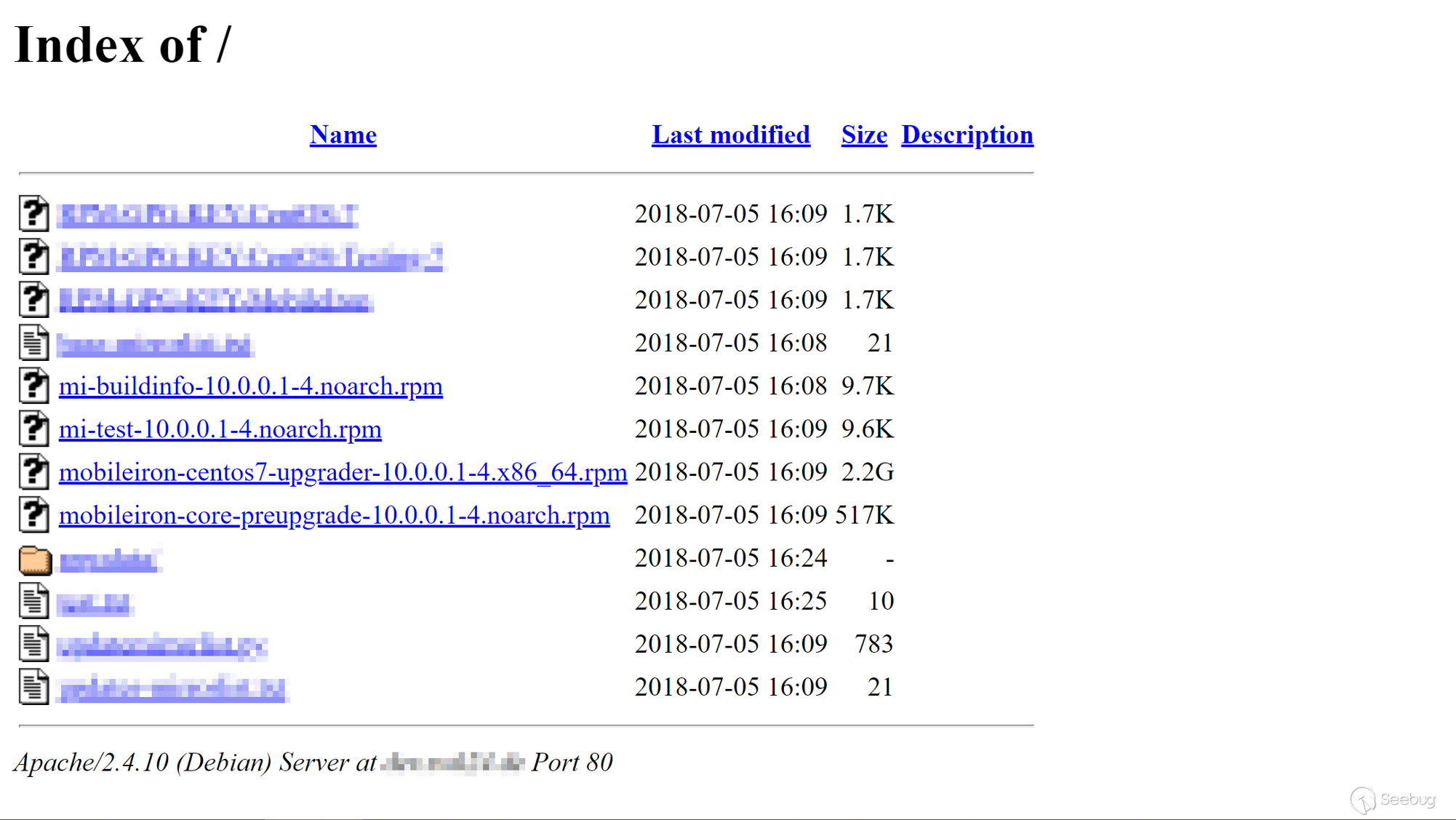](https://images.seebug.org/1600148517603-w331s)
Anyway, we got a file to research. The released date of the file is in early
2018. It seems a little bit old but still better than nothing!
_P.S. We have informed MobileIron and the sensitive files has been removed
now._
## Finding Vulnerabilities
After a painful time solving the dependency hell, we set the testing package
up finally. The component is based on Java and exposed three ports:
* 443 - the user enrollment interface
* 8443 - the appliance management interface
* 9997 - the MobileIron device synchronization protocol (MI Protocol)
All opened ports are TLS-encrypted. Apache is in the front of the web part and
proxies all connections to backend, a Tomcat with Spring MVC inside.
[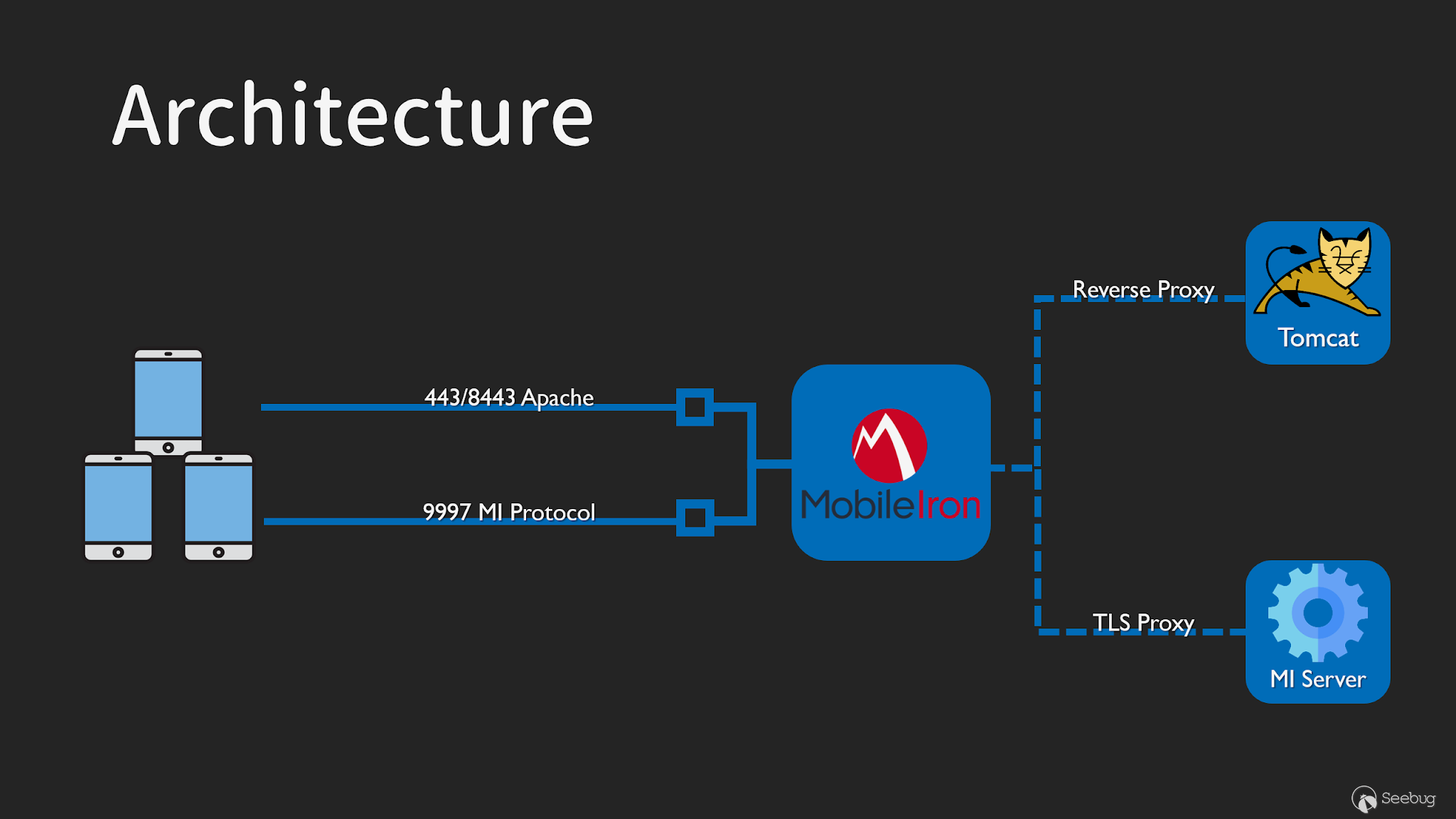](https://images.seebug.org/1600148520552-w331s)
Due to the Spring MVC, it's hard to find traditional vulnerabilities like SQL
Injection or XSS from a single view. Therefore, examining the logic and
architecture is our goal this time!
Talking about the vulnerability, the root cause is straightforward. Tomcat
exposed a Web Service that deserializes user input with Hessian format.
However, this doesn't mean we can do everything! The main effort of this
article is to solve that, so please see the exploitation below.
Although we know the Web Service deserializes the user input, we can not
trigger it. The endpoint is located on both:
* User enrollment interface - `https://mobileiron/mifs/services/`
* Management interface - `https://mobileiron:8443/mics/services/`
We can only touch the deserialization through the management interface because
the user interface blocks the Web Service access. It's a critical hit for us
because most enterprises won't expose their management interface to the
Internet, and a management-only vulnerability is not useful to us so that we
have to try harder. :(
Scrutinizing the architecture, we found Apache blocks our access through
Rewrite Rules. It looks good, right?
RewriteRule ^/mifs/services/(.*)$ https://%{SERVER_NAME}:8443/mifs/services/$1 [R=307,L]
RewriteRule ^/mifs/services [F]
MobileIron relied on Apache Rewrite Rules to block all the access to Web
Service. It's in the front of a reverse-proxy architecture, and the backend is
a Java-based web server.
Have you recalled something?
Yes, the [Breaking Parser Logic](https://blog.orange.tw/2018/08/how-i-
chained-4-bugs-features-into-rce-on-amazon.html)! It's the reverse proxy attack surface I [proposed in 2015](https://github.com/orangetw/My-CTF-Web-
Challenges#blackbox), and presented at [Black Hat USA 2018](https://www.blackhat.com/us-18/briefings.html#breaking-parser-logic-
take-your-path-normalization-off-and-pop-0days-out). This technique leverage
the inconsistency between the Apache and Tomcat to bypass the ACL control and
reaccess the Web Service. BTW, this excellent technique is also applied to the
recently [F5 BIG-IP TMUI RCE vulnerability](https://support.f5.com/csp/article/K52145254)!
https://mobileiron/mifs/.;/services/someService
## Exploiting Vulnerabilities
OK, now we have access to the deserialization wherever it's on enrollment
interface or management interface. Let's go back to exploitations!
[Moritz Bechler](https://github.com/mbechler) has an awesome research which
summarized the Hessian deserialization vulnerability on his whitepaper, [Java
Unmarshaller
Security](https://www.github.com/mbechler/marshalsec/blob/master/marshalsec.pdf).
From the [marshalsec](https://github.com/mbechler/marshalsec) source code, we
learn the Hessian deserialization triggers the `equals()` and `hashcode()`
while reconstructing a `HashMap`. It could also trigger the `toString()`
through the `XString`, and the known exploit gadgets so far are:
* Apache XBean
* Caucho Resin
* Spring AOP
* ROME EqualsBean/ToStringBean
In our environment, we could only trigger the Spring AOP gadget chain and get
a JNDI Injection.
| | Name | Effect |
| ----- | --------------- | ------------------ |
| x | Apache XBean | JNDI Injection |
| x | Caucho Resin | JNDI Injection |
| **√** | **Spring AOP** | **JNDI Injection** |
| x | ROME EqualsBean | RCE |
Once we have a JNDI Injection, the rest parts of exploitations are easy! We
can just leverage [Alvaro Muñoz](https://twitter.com/pwntester) and [Oleksandr
Mirosh](https://twitter.com/olekmirosh)'s work, [A Journey From JNDI/LDAP to
Remote Code Execution Dream
Land](https://www.blackhat.com/us-16/briefings.html#a-journey-from-jndi-ldap-
manipulation-to-remote-code-execution-dream-land), from Black Hat USA 2016 to
get the code execution… Is that true?
[](https://images.seebug.org/1600148522535-w331s)
Since [Alvaro Muñoz](https://twitter.com/pwntester) and [Oleksandr
Mirosh](https://twitter.com/olekmirosh) introduced this on Black Hat, we could
say that this technique helps countless security researchers and brings Java
deserialization vulnerability into a new era. However, Java finally mitigated
the last JNDI/LDAP puzzle in [October
2018](https://www.oracle.com/java/technologies/javase/8u181-relnotes.html).
After that, all java version higher than 8u181, 7u191, and 6u201 can no longer
get code execution through JNDI remote URL-Class loading. Therefore, if we
exploit the Hessian deserialization on the latest MobileIron, we must face
this problem!
Java changed the default value of `com.sun.jndi.ldap.object.trustURLCodebase`
to `False` to prevent attackers from downloading remote URL-Class to get code
executions. But only this has been prohibited. We can still manipulate the
JNDI and redirect the Naming Reference to a local Java Class!
The concept is a little bit similar to [Return-Oriented
Programming](https://en.wikipedia.org/wiki/Return-oriented_programming),
utilizing a local existing Java Class to do further exploitations. You can
refer to the article [Exploiting JNDI Injections in
Java](https://www.veracode.com/blog/research/exploiting-jndi-injections-java)
by [Michael Stepankin](https://twitter.com/artsploit) in early 2019 for
details. It describes the attack on POST-JNDI exploitations and how to abuse
the Tomcat's `BeanFactory` to populate the `ELProcessor` gadget to get code
execution. Based on this concept, researcher
[Welkin](https://github.com/welk1n) also provides another `ParseClass` gadget
on Groovy. As described in [his (Chinese)
article](https://www.cnblogs.com/Welk1n/p/11066397.html):
> 除了 javax.el.ELProcessor,当然也还有很多其他的类符合条件可以作为 beanClass 注入到 BeanFactory
> 中实现利用。举个例子,如果目标机器 classpath 中有 groovy 的库,则可以结合之前 Orange 师傅发过的 [Jenkins
> 的漏洞实现利用](https://blog.orange.tw/2019/02/abusing-meta-programming-for-
> unauthenticated-rce.html)
It seems the Meta Programming exploitation in my previous Jenkins research
could be used here as well. It makes the Meta Programming great again :D
The approach is fantastic and looks feasible for us. But both gadgets
`ELProcessor` and `ParseClass` are unavailable due to our outdated target
libraries. Tomcat introduced the `ELProcessor` since 8.5, but our target is 7.
As for the Groovy gadget, the target Groovy version is too old (1.5.6 from
2008) to support the Meta Programming, so we still have to find a new gadget
by ourselves. We found a new gadget on `GroovyShell` in the end. If you are
interested, you can check the [Pull Request](https://github.com/welk1n/JNDI-
Injection-Bypass/pull/1) I sent to the [JNDI-Injection-
Bypass](https://github.com/welk1n/JNDI-Injection-Bypass) project!
## Attacking Facebook
Now we have a perfect RCE by chaining JNDI Injection, Tomcat `BeanFactory` and
`GroovyShell`. It's time to hack Facebook!
Aforementioned, we knew the Facebook uses MobileIron since 2016. Although the
server's index responses 403 Forbidden now, the Web Service is still
accessible!
[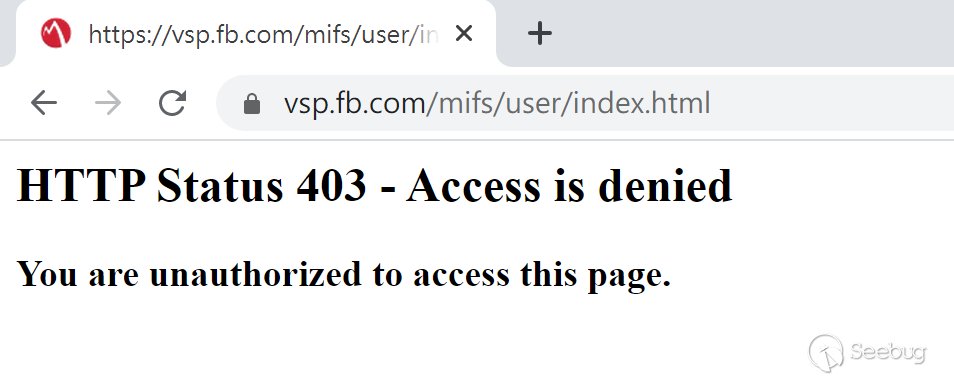](https://images.seebug.org/1600148538547-w331s)
Everything is ready and wait for our exploit! However, several days before our
scheduled attack, we realized that there is a critical problem in our exploit.
From [our last time popping shell on
Facebook](https://devco.re/blog/2016/04/21/how-I-hacked-facebook-and-found-
someones-backdoor-script-eng-ver/), we noticed it blocks outbound connections
due to security concerns. The outbound connection is vital for JNDI Injection
because the idea is to make victims connecting to a malicious server to do
further exploitations. But now, we can't even make an outbound connection, not
to mention others.
[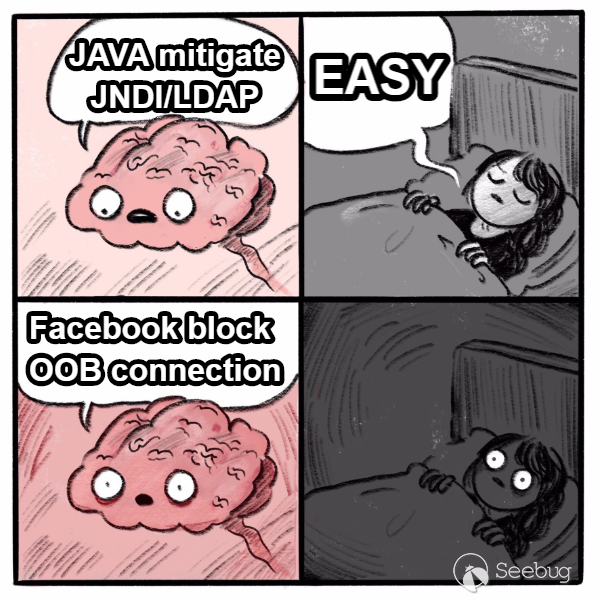](https://images.seebug.org/1600148541293-w331s)
So far, all attack surfaces on JNDI Injection have been closed, we have no
choice but to return to Hessian deserialization. But due to the lack of
available gadgets, we must discover a new one by ourselves!
[](https://images.seebug.org/1600148554323-w331s)
Before discovering a new gadget, we have to understand the existing gadgets'
root cause properly. After re-reading Moritz Bechler's
[paper](https://www.github.com/mbechler/marshalsec/blob/master/marshalsec.pdf),
a certain word interested me:
> Cannot restore Groovy's MethodClosure as readResolve() is called which
> throws an exception.
A question quickly came up in my mind: Why did the author leave this word
here? Although it failed with exceptions, there must have been something
special so that the author write this down.
Our target is running with a very old Groovy, so we are guessing that the
`readResolve()` constrain might not have been applied to the code base yet! We
compared the file `groovy/runtime/MethodClosure.java` between the latest and
1.5.6.
$ diff 1_5_6/MethodClosure.java 3_0_4/MethodClosure.java
> private Object readResolve() {
> if (ALLOW_RESOLVE) {
> return this;
> }
> throw new UnsupportedOperationException();
> }
Yes, we are right. There is no `ALLOW_RESOLVE` in Groovy 1.5.6, and we later
learned [CVE-2015-3253](https://groovy-lang.org/security.html) is just for
that. It's a mitigation for the rising Java deserialization vulnerability in
2015. Since Groovy is an internally used library, developers won't update it
if there is no emergency. The outdated Groovy could also be a good case study
to demonstrated how a harmless component can leave you compromised!
Of course we got the shell on Facebook in the end. Here is the video:
## __Vulnerability Report and Patch
We have done all the research on March and sent the advisory to MobileIron at
4/3. The MobileIron released the patch on 6/15 and addressed three CVEs for
that. You can check the [official website](https://www.mobileiron.com/en/blog/mobileiron-security-updates-
available) for details!
* CVE-2020-15505 - Remote Code Execution
* CVE-2020-15506 - Authentication Bypass
* CVE-2020-15507 - Arbitrary File Reading
After the patch has been released, we start monitoring the Internet to track
the overall fixing progress. Here we check the `Last-Modified` header on
static files so that the result is just for your information. (Unknown stands
for the server closed both 443 and 8443 ports)
[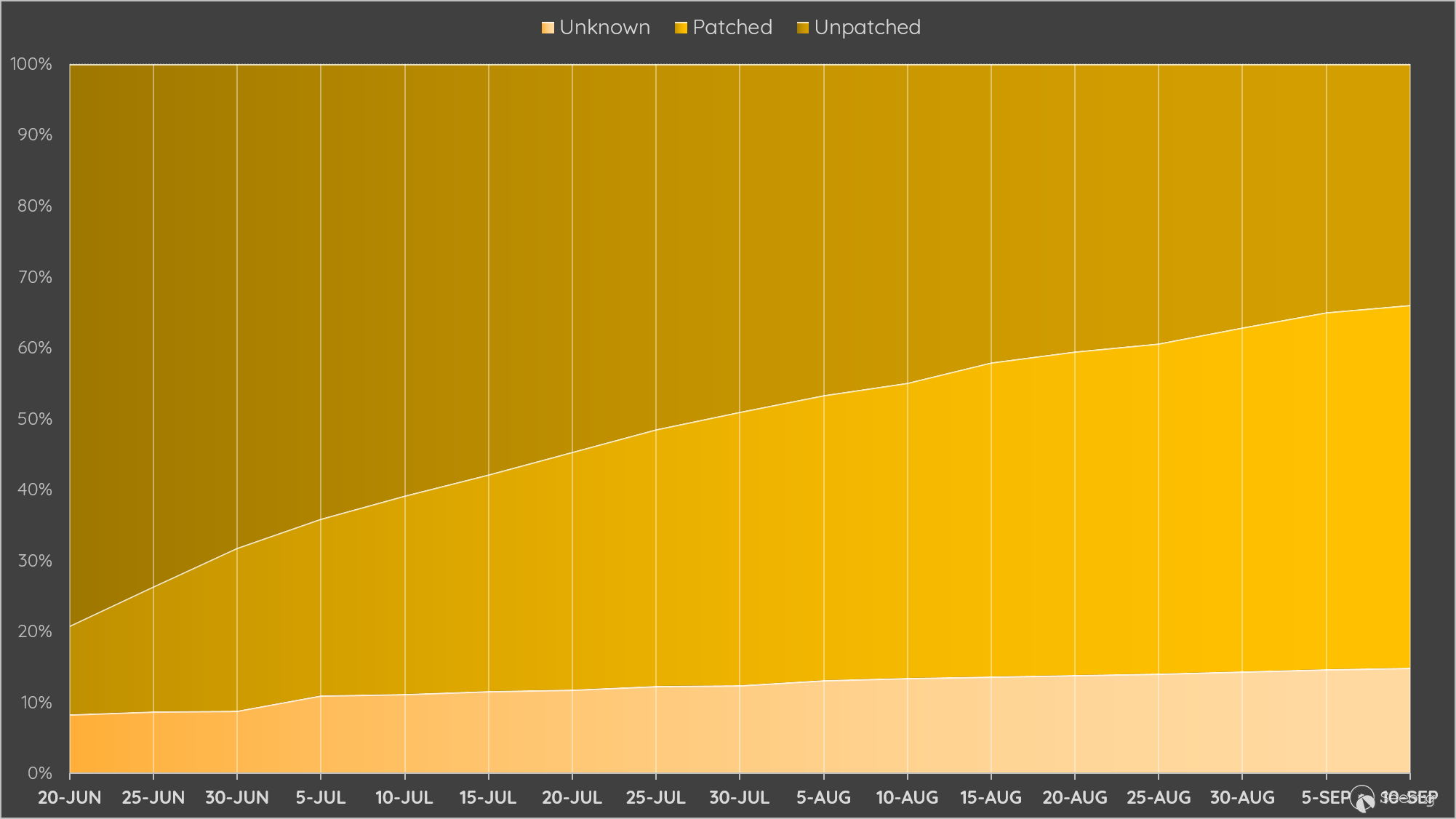](https://images.seebug.org/1600148555766-w331s)
At the same time, we keep our attentions on Facebook as well. With 15 days no-
patch confirm, we finally popped a shell and report to their Bug Bounty
program at 7/2!
## Conclusion
So far, we have demonstrated a completely unauthenticated RCE on MobileIron.
From how we get the firmware, find the vulnerability, and bypass the JNDI
mitigation and network limitation. There are other stories, but due to the
time, we have just listed topics here for those who are interested:
* How to take over the employees' devices from MDM
* Disassemble the MI Protocol
* And the CVE-2020-15506, an interesting authentication bypass
I hope this article could draw attention to MDM and the importance of
enterprise security! Thanks for reading. :D


暂无评论